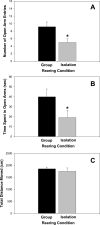Anxiety states induced by post-weaning social isolation are mediated by CRF receptors in the dorsal raphe nucleus
- PMID: 21396988
- PMCID: PMC3109218
- DOI: 10.1016/j.brainresbull.2011.03.003
Anxiety states induced by post-weaning social isolation are mediated by CRF receptors in the dorsal raphe nucleus
Abstract
Post-weaning social isolation of rats is utilized as a model of early life stress. We have previously demonstrated that rats exposed to post-weaning social isolation exhibit greater anxiety-like behaviors as adults. Furthermore, these rats exhibit greater density of corticotropin-releasing factor (CRF) type 2 receptors in the dorsal raphe nucleus. Therefore, we examined whether antagonism of CRF(2) receptors in the dorsal raphe nucleus reverses the effects of post-weaning social isolation on anxiety states. Male rats were reared in isolation or in groups from day of weaning (postnatal day [PND] 21) to mid-adolescence (PND42) and then allowed to develop to early adulthood housed in groups. At PND62, rats were either infused with vehicle, the CRF(1) receptor antagonist antalarmin (0.25-0.5 μg) or the CRF(2) receptor antagonist antisauvagine-30 (2 μg) into the dorsal raphe nucleus, 20 min prior to being introduced to the elevated plus maze. Isolation-reared rats showed reduced open arm behavior compared to group-reared rats, confirming the anxiogenic effects of post-weaning social isolation. Infusion of the CRF(2) receptor antagonist, but not the CRF(1) receptor antagonist, into the dorsal raphe nucleus of isolation-reared rats increased open arm behavior when compared to that of group-reared rats. Overall, the findings suggest that CRF(2) receptors within the dorsal raphe nucleus mediate anxiety-like states following post-weaning social isolation, and CRF(2) receptors may represent an important target for the treatment of anxiety disorders following early life stressors.
Copyright © 2011 Elsevier Inc. All rights reserved.
Figures



Similar articles
-
Negative consequences of early-life adversity on substance use as mediated by corticotropin-releasing factor modulation of serotonin activity.Neurobiol Stress. 2018 Aug 7;9:29-39. doi: 10.1016/j.ynstr.2018.08.001. eCollection 2018 Nov. Neurobiol Stress. 2018. PMID: 30151419 Free PMC article. Review.
-
Corticotropin-releasing factor receptor antagonism within the dorsal raphe nucleus reduces social anxiety-like behavior after early-life social isolation.J Neurosci. 2009 Aug 12;29(32):9955-60. doi: 10.1523/JNEUROSCI.0854-09.2009. J Neurosci. 2009. PMID: 19675229 Free PMC article.
-
Corticotropin-releasing factor 1 and 2 receptors in the dorsal raphé differentially affect serotonin release in the nucleus accumbens.Eur J Pharmacol. 2008 Jan 14;578(2-3):185-93. doi: 10.1016/j.ejphar.2007.09.024. Epub 2007 Oct 2. Eur J Pharmacol. 2008. PMID: 17945210 Free PMC article.
-
Corticotropin-releasing factor in the dorsal raphe nucleus increases medial prefrontal cortical serotonin via type 2 receptors and median raphe nucleus activity.Eur J Neurosci. 2008 Jul;28(2):299-310. doi: 10.1111/j.1460-9568.2008.06333.x. Eur J Neurosci. 2008. PMID: 18702701 Free PMC article.
-
Collateralized dorsal raphe nucleus projections: a mechanism for the integration of diverse functions during stress.J Chem Neuroanat. 2011 Jul;41(4):266-80. doi: 10.1016/j.jchemneu.2011.05.011. Epub 2011 May 30. J Chem Neuroanat. 2011. PMID: 21658442 Free PMC article. Review.
Cited by
-
Effect of post-weaning isolation on anxiety- and depressive-like behaviors of C57BL/6J mice.Exp Brain Res. 2017 Sep;235(9):2893-2899. doi: 10.1007/s00221-017-5021-5. Epub 2017 Jul 10. Exp Brain Res. 2017. PMID: 28695280
-
The role of dorsal raphe nucleus neuropeptides in reward and aversion.Front Behav Neurosci. 2025 Apr 9;19:1553470. doi: 10.3389/fnbeh.2025.1553470. eCollection 2025. Front Behav Neurosci. 2025. PMID: 40270681 Free PMC article. Review.
-
Identification of Cholecystokinin by Genome-Wide Profiling as Potential Mediator of Serotonin-Dependent Behavioral Effects of Maternal Separation in the Amygdala.Front Neurosci. 2019 May 10;13:460. doi: 10.3389/fnins.2019.00460. eCollection 2019. Front Neurosci. 2019. PMID: 31133792 Free PMC article.
-
Live predator stress in adolescence results in distinct adult behavioral consequences and dorsal diencephalic brain activation patterns.Behav Brain Res. 2021 Feb 26;400:113028. doi: 10.1016/j.bbr.2020.113028. Epub 2020 Dec 9. Behav Brain Res. 2021. PMID: 33309751 Free PMC article.
-
Negative consequences of early-life adversity on substance use as mediated by corticotropin-releasing factor modulation of serotonin activity.Neurobiol Stress. 2018 Aug 7;9:29-39. doi: 10.1016/j.ynstr.2018.08.001. eCollection 2018 Nov. Neurobiol Stress. 2018. PMID: 30151419 Free PMC article. Review.
References
-
- Amat J, Tamblyn JP, Paul ED, Bland ST, Amat P, Foster AC, Watkins LR, Maier SF. Microinjection of urocortin 2 into the dorsal raphé nucleus activates serotonergic neurons and increases extracellular serotonin in the basolateral amygdala. Neuroscience. 2004;129:509–519. - PubMed
-
- Andersen SL. Trajectories of brain development: point of vulnerability or window of opportunity? Neurosci. Biobehav. Rev. 2003;27:3–18. - PubMed
-
- Arakawa H. Interaction between isolation rearing and social development on exploratory behavior in male rats. Behav. Processes. 2005;70:223–234. - PubMed
-
- Arakawa H. Ontogenetic interaction between social relationships and defensive burying behavior in the rat. Physiol. Behav. 2007;90:751–759. - PubMed
-
- Bale TL, Contarino A, Smith GW, Chan R, Gold LH, Sawchenko PE, Koob GE, Vale WW, Lee KF. Mice deficient for corticotropin-releasing hormone receptor-2 display anxiety-like behaviour and are hypersensitive to stress. Nat. Genet. 2000;24:410–414. - PubMed

